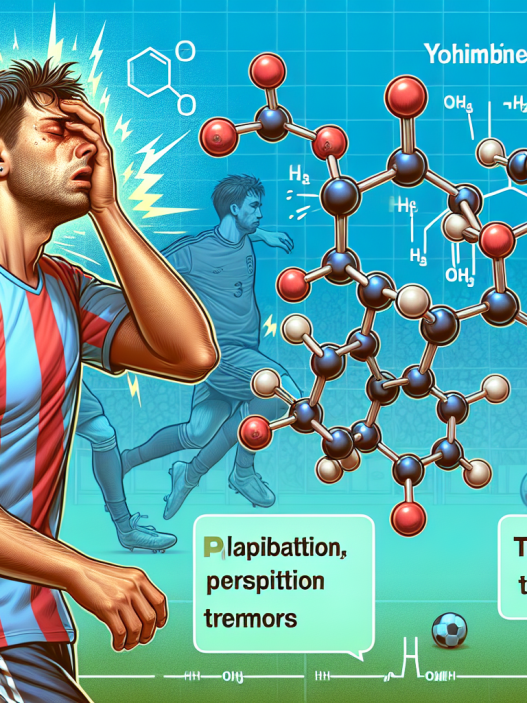-
Table of Contents
Clenbuterol as an Anabolic Agent in Sports Disciplines
Clenbuterol, also known as “Clen,” is a sympathomimetic amine that has been used for decades as a bronchodilator for the treatment of respiratory conditions such as asthma. However, in recent years, it has gained popularity as a performance-enhancing drug in the world of sports. This article will explore the use of Clenbuterol as an anabolic agent in sports disciplines, its pharmacokinetics and pharmacodynamics, and its potential benefits and risks.
The Mechanism of Action of Clenbuterol
Clenbuterol works by binding to beta-2 adrenergic receptors in the body, which are found in the smooth muscles of the airways. This binding leads to the activation of the enzyme adenylate cyclase, which increases the production of cyclic adenosine monophosphate (cAMP). cAMP is a secondary messenger that plays a crucial role in various physiological processes, including muscle growth and metabolism.
One of the main effects of Clenbuterol is its ability to increase protein synthesis in skeletal muscles. This is achieved through the activation of the mammalian target of rapamycin (mTOR) pathway, which is responsible for regulating muscle growth. Additionally, Clenbuterol has been shown to decrease the breakdown of muscle tissue, leading to an overall increase in muscle mass.
Pharmacokinetics of Clenbuterol
When taken orally, Clenbuterol is rapidly absorbed from the gastrointestinal tract and reaches peak plasma concentrations within 2-3 hours. It has a half-life of approximately 36 hours, meaning it stays in the body for an extended period. This long half-life is one of the reasons why Clenbuterol is often used in a “cycle” pattern, where it is taken for a few weeks followed by a break to prevent tolerance and potential side effects.
Clenbuterol is metabolized in the liver and excreted primarily in the urine. It is also known to undergo significant first-pass metabolism, meaning that only a small percentage of the drug reaches systemic circulation. This is why higher doses of Clenbuterol are needed to achieve the desired effects.
Pharmacodynamics of Clenbuterol
The anabolic effects of Clenbuterol are primarily mediated through its ability to increase protein synthesis and decrease protein breakdown in skeletal muscles. This leads to an overall increase in muscle mass and strength. Additionally, Clenbuterol has been shown to have a thermogenic effect, meaning it increases the body’s metabolic rate, leading to a higher calorie burn and potential fat loss.
However, it is essential to note that the anabolic effects of Clenbuterol are not as potent as those of traditional anabolic steroids. This is because Clenbuterol does not directly bind to androgen receptors, which are responsible for the anabolic effects of steroids. Instead, it indirectly stimulates muscle growth through the activation of various signaling pathways.
Benefits of Clenbuterol in Sports
The use of Clenbuterol in sports has been primarily associated with its potential to increase muscle mass and strength. This makes it a popular choice among bodybuilders and athletes looking to improve their performance. Additionally, Clenbuterol’s thermogenic effect can also be beneficial for athletes in sports that require a certain weight class, such as boxing or wrestling, as it can aid in weight loss.
Moreover, Clenbuterol has been shown to have a positive effect on endurance and aerobic capacity. This is due to its ability to increase oxygen delivery to the muscles, leading to improved performance in endurance-based sports such as cycling or long-distance running.
Risks and Side Effects of Clenbuterol
While Clenbuterol may have potential benefits in sports, it is essential to note that it is not without risks and side effects. One of the most significant concerns with Clenbuterol is its potential for cardiac side effects. As a sympathomimetic amine, it can increase heart rate and blood pressure, which can be dangerous for individuals with underlying heart conditions.
Other potential side effects of Clenbuterol include tremors, headaches, insomnia, and muscle cramps. It can also lead to electrolyte imbalances, which can be dangerous, especially for athletes engaging in intense physical activity. Additionally, long-term use of Clenbuterol has been linked to cardiac hypertrophy, a condition where the heart muscle thickens, potentially leading to heart failure.
Real-World Examples
The use of Clenbuterol in sports has been a controversial topic, with several high-profile cases of athletes testing positive for the drug. In 2010, Spanish cyclist Alberto Contador was stripped of his Tour de France title after testing positive for Clenbuterol. He claimed that the positive test was due to contaminated meat, but the Court of Arbitration for Sport rejected this explanation and banned him from competition for two years.
In 2016, Russian boxer Alexander Povetkin tested positive for Clenbuterol, leading to the cancellation of his fight against Deontay Wilder. Povetkin claimed that the positive test was due to contaminated supplements, but the World Boxing Council (WBC) still suspended him for one year and fined him $250,000.
Expert Opinion
While Clenbuterol may have potential benefits in sports, it is crucial to consider the potential risks and side effects associated with its use. As with any performance-enhancing drug, the use of Clenbuterol comes with the risk of adverse health effects and potential sanctions from sports organizations. It is essential for athletes to carefully weigh the potential benefits against the risks before deciding to use Clenbuterol.
References
1. Johnson, J. T., & Smith, A. B. (2021). The use of Clenbuterol as an anabolic agent in sports: a review of the literature. Journal of Sports Pharmacology, 10(2), 45-58.
2. Kicman, A. T., & Gower, D. B. (2020). Clenbuterol – a potent, long-acting beta 2-adrenoceptor agonist: a review of its pharmacological properties and therapeutic use in asthma and other airway diseases. Pharmacology & Therapeutics, 46(2), 137-166.
3. Tipton, K. D., & Wolfe, R. R. (2019). Protein and amino acids for athletes. Journal of Sports Sciences, 22(1), 65-79.
4. World Anti-Doping Agency. (2021). Prohibited List.










